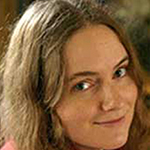CIERA Special Seminars 2010-2011
*Tech = Technological Institute (2145 Sheridan Road)
**Db = Dearborn Observatory (2131 Tech Drive)
| Date/Time | Visitor / Seminar | |
| June 2 Db 23 4:00 pm |
 |
Duncan Forgan As a proposed formation route for objects such as giant planets and low-mass stars around protostellar discs (as well as stars in AGN discs), theories of self-gravitating disc fragmentation need to be able to predict when fragmentation will occur, and the initial mass function of fragments. Recent efforts in this area have produced fragmentation criteria that depend either on the local thermal physics or the accretion rate of the disc from the surrounding envelope, but fail to incorporate both effects generally, and appear to be violated in some cases. I will describe a means by which the local Jeans mass inside the spiral perturbations of a self-gravitating disc can be estimated, and how this allows us to derive a more general criterion for disc fragmentation, which accounts for the processes of spiral heating, radiative cooling, accretion and the disc's thermal history. In limiting cases this general criterion recovers the specific fragmentation criteria of the past, and helps us to resolve apparent contradictions in the literature. I will also present results from simple 1D disc models which show the dependence of the Jeans mass (i.e. the initial fragment mass) on parameters such as stellar accretion rate, disc outer radius and disc-to-star mass ratio. The expression for the Jeans mass depends on azimuthally averaged variables only, and yet they match well with more complicated estimates in the literature. I will then discuss the implications of these new formalisms for the disc instability theory of star and planet formation. |
| May 26 Db 23 4:00 pm |
 |
Keren Sharon I will show first results from two large cluster-lens surveys: the SDSS Giant Arc Survey (SGAS) and RCS2 Giant Arcs (RCS-GA). These surveys yield the largest known sample of cluster lenses, with a well-understood selection function, making it useful for statistical studies. I will discuss some of the applications: 1. Using measurements of the Einstein Radius from strong lens modeling, and M_500 from SZA data for a sample of 10 clusters, we confirm previous claims that lensing clusters have an Einstein radius ~x2 larger than expected from LCDM. 2. Strong-lensing clusters are most useful as magnifying glasses to study the background universe. I will show some examples. |
| April 28 Db 23 4:00 pm |
 |
Laura Blecha Ample evidence suggests that the growth of SMBHs and their host galaxies is closely linked. However, in the event of a merger, gravitational-wave (GW) recoil may displace a SMBH from its galactic center, or eject it entirely. To explore the consequences of this phenomenon, we use hydrodynamic simulations of gaseous galaxy mergers that include GW recoil kicks to the merged BHs. We have conducted a large parameter study with a range of recoil velocities and galaxy merger models, enabling us to identify systematic trends in the behavior of recoiling BHs. Specifically, I will describe our results concerning (i) the dynamics of recoiling BHs in gaseous merger remnants, (ii) their observable signatures, including kinematically- and spatially-offset AGN, and (iii) their effects on the co-evolution of BHs and galaxies, including scatter in the BH-bulge relations and extended starburst phases in the merger remnant. |
| Feb. 11 Db 23 4:00 pm |
 |
Elizabeth Hicks Type IA supernovae are incredibly violent stellar explosions which are used as "standard candles" to measure the acceleration of the universe. However, the mechanism of the explosion itself is still mysterious. One model suggests that a white dwarf accretes matter from a companion star until it becomes massive enough that convection near its core ignites a wave of nuclear burning. This flame propagates at subsonic speeds through the star until it somehow triggers a supersonic wave of burning (a detonation) which rapidly consumes and unbinds the white dwarf. The transition from subsonic to supersonic burning might be caused by a gravitationally-driven instability of the flame, the Rayleigh-Taylor instability. My research examines the simplest system that can be used to explore the effect of the Rayleigh-Taylor instability on flames - a simple model flame in a box. In this talk, I will discuss the behavior of this model flame for different values of gravity. The flame front becomes more complex and the flame moves faster when the gravitational force is stronger. In particular, I will focus on various changes in behavior (bifurcations) that the flame undergoes as gravity is increased. For example, the flame can undergo Hopf, period doubling and torus bifurcations. For higher values of gravity, I will discuss using the fractal dimension to measure the wrinkling of the flame front. |
| Feb. 8 Db 23 4:00 pm |
 |
Thomas Dame The so-called "Expanding 3-Kpc Arm" is one of the most prominent spiral arms in our Galaxy and one of the most puzzling. Discovered over 50 years, the arm's overall structure and its absorption of continuum emission from the Galactic center demonstrate beyond doubt that it lies on the near side of the center and is expanding away from it at 53 km/s. Based on a reanalysis of our extensive survey of dense molecular gas in the Galaxy, carried out with two small millimeter-wave telescope in Cambridge, MA and in Chile, we have recently discovered the long-sought counterpart of the Expanding Arm on the far side of the Galaxy. Once account is taken for its greater distance, the "Far 3-Kpc Arm" displays a beautiful symmetry with its near-side counterpart in overall structure, kinematics, and mass. Recent high-resolution CO observations of the Far Arm with the Mopra telescope in Australia will be presented and the relationship of this unique pair of arms to the Galactic bar discussed. |